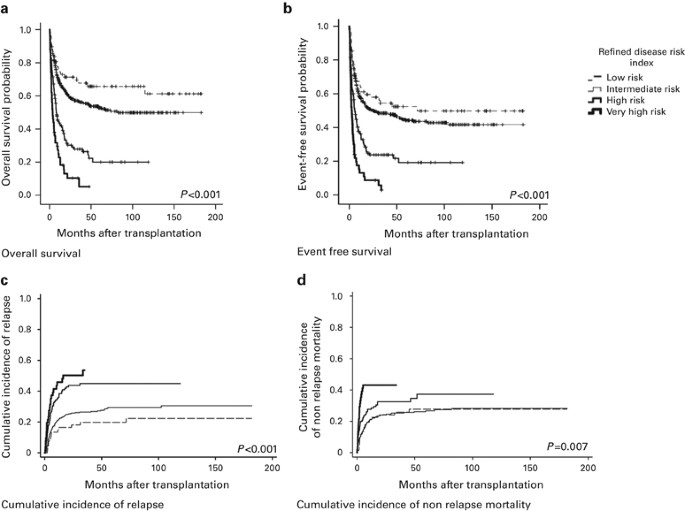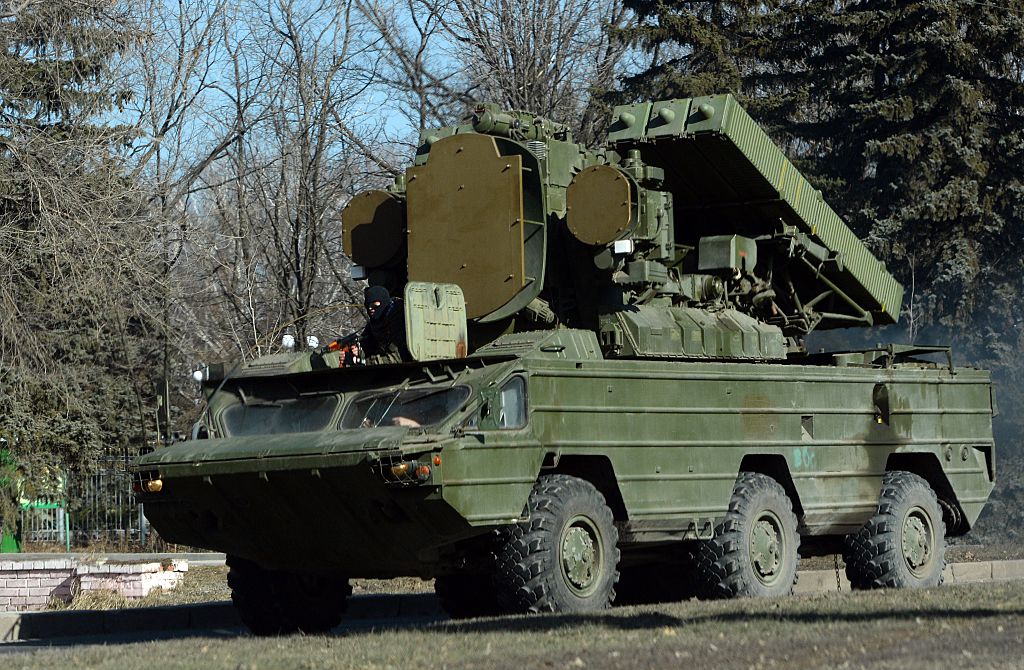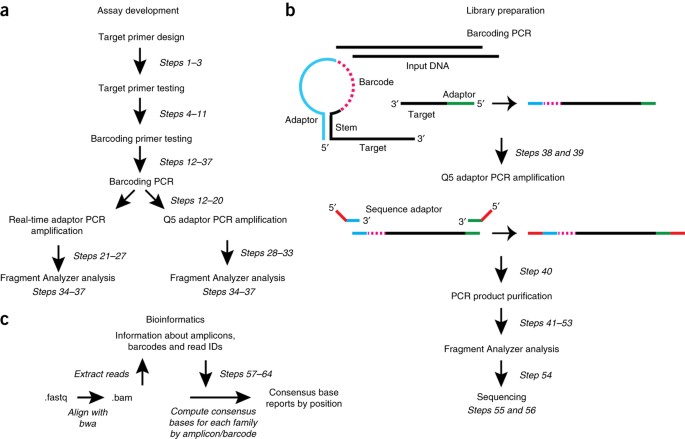
- Select a language for the TTS:
- UK English Female
- UK English Male
- US English Female
- US English Male
- Australian Female
- Australian Male
- Language selected: (auto detect) - EN
Play all audios:
ABSTRACT The refined disease risk index (DRI) is a powerful prognostic model based solely on the disease type and stage for predicting survival outcomes of various hematological malignancies
after allogeneic transplant. Here, we analyzed our series of 690 patients transplanted over the past 15 years, and showed that besides overall survival (OS), the refined DRI is also able to
segregate event-free survival and relapse mortality in our cohort of largely Southeast Asian patients with a long and complete follow-up. Stratification by refined DRI remains statistically
significant even when broken down by specific diseases each with a smaller number of patients, as well as for a small subset of patients younger than 18 years old, providing a robust model
for prognostication. Multivariable analysis shows that refined DRI, age, year of transplant and donor type are independent risk factors for OS. We further demonstrated here that
prognostication for a given patient with a specific disease can be made more discriminating by integrating independent risk factors such as age and donor type with the refined DRI. The
future development of prognostic system incorporating the refined DRI with patient- and transplant-related risk factors will provide a more precise estimate of transplant outcome. Access
through your institution Buy or subscribe This is a preview of subscription content, access via your institution ACCESS OPTIONS Access through your institution Subscribe to this journal
Receive 12 print issues and online access $259.00 per year only $21.58 per issue Learn more Buy this article * Purchase on SpringerLink * Instant access to full article PDF Buy now Prices
may be subject to local taxes which are calculated during checkout ADDITIONAL ACCESS OPTIONS: * Log in * Learn about institutional subscriptions * Read our FAQs * Contact customer support
SIMILAR CONTENT BEING VIEWED BY OTHERS A NOVEL IOWA–MAYO VALIDATED COMPOSITE RISK ASSESSMENT TOOL FOR ALLOGENEIC STEM CELL TRANSPLANTATION SURVIVAL OUTCOME PREDICTION Article Open access 20
November 2021 PREDICTING NON-RELAPSE MORTALITY FOLLOWING ALLOGENEIC HEMATOPOIETIC CELL TRANSPLANTATION DURING FIRST REMISSION OF ACUTE MYELOID LEUKEMIA Article 14 August 2020 PROGNOSTIC
PREDICTION OF NOVEL RISK SCORES (AML-DRG AND AML-HCT-CR) IN ACUTE MYELOID LEUKEMIA PATIENTS WITH ALLOGENEIC HEMATOPOIETIC STEM CELL TRANSPLANTATION Article Open access 08 November 2022
REFERENCES * Sorror ML, Maris MB, Storb R, Baron F, Sandmaier BM, Maloney DG _et al_. Hematopoietic cell transplantation (HCT)-specific comorbidity index: a new tool for risk assessment
before allogeneic HCT. _Blood_ 2005; 106: 2912–2919. Article CAS Google Scholar * Sorror ML, Storb RF, Sandmaier BM, Maziarz RT, Pulsipher MA, Maris MB _et al_. Comorbidity-age index: a
clinical measure of biologic age before allogeneic hematopoietic cell transplantation. _J Clin Oncol_ 2014; 32: 3249–3256. Article Google Scholar * Gratwohl A, Stern M, Brand R, Apperley
J, Baldomero H, de Witte T _et al_. Risk score for outcome after allogeneic hematopoietic stem cell transplantation: a retrospective analysis. _Cancer_ 2009; 115: 4715–4726. Article Google
Scholar * Armand P, Gibson CJ, Cutler C, Ho VT, Koreth J, Alyea EP _et al_. A disease risk index for patients undergoing allogeneic stem cell transplantation. _Blood_ 2012; 120: 905–913.
Article CAS Google Scholar * Armand P, Kim HT, Logan BR, Wang Z, Alyea EP, Kalaycio ME _et al_. Validation and refinement of the Disease Risk Index for allogeneic stem cell
transplantation. _Blood_ 2014; 123: 3664–3671. Article CAS Google Scholar * European Group for Blood and Marrow Transplantation. Definitions and evaluation of endpoints following stem
cells transplantation - recommendation from the European Group for Blood and Marrow transplantation (EBMT). Available at
https://portal.ebmt.org/sites/clint2/clint/Documents/Statistical%20Endpoints_CLINT%20Project_final%20version.pdf. Accessed on 19 June 2016. * Bacigalupo A, Ballen K, Rizzo D, Giralt S,
Lazarus H, Ho V _et al_. Defining the intensity of conditioning regimens: working definitions. _Biol Blood Marrow Transplant_ 2009; 15: 1628–1633. Article Google Scholar * Arber DA, Orazi
A, Hasserjian R, Thiele J, Borowitz MJ, Le Beau MM _et al_. The 2016 revision to the World Health Organization classification of myeloid neoplasms and acute leukemia. _Blood_ 2016; 127:
2391–2405. Article CAS Google Scholar * Beauverd Y, Roosnek E, Tirefort Y, Nagy-Hulliger M, Bernimoulin M, Tsopra O _et al_. Validation of the disease risk index for outcome of patients
undergoing allogeneic hematopoietic stem cell transplantation after T cell depletion. _Biol Blood Marrow Transplant_ 2014; 20: 1322–1328. Article Google Scholar * Lim AB, Roberts AW, Mason
K, Bajel A, Szer J, Ritchie DS _et al_. Validating the allogeneic stem cell transplantation disease risk index: sample size, follow-up, and local data are important. _Transplantation_ 2015;
99: 128–132. Article CAS Google Scholar * McCurdy SR, Kanakry JA, Showel MM, Tsai HL, Bolaños-Meade J, Rosner GL _et al_. Risk-stratified outcomes of nonmyeloablative HLA-haploidentical
BMT with high-dose posttransplantation cyclophosphamide. _Blood_ 2015; 125: 3024–3031. Article CAS Google Scholar * Lupo-Stanghellini MR, Sala E, Piemontese S, Morelli M, Greco R,
Marcatti M _et al_. Refined Disease Risk Index (DRI) and Hematopoietic Cell Transplantation Comorbidity Index (HCT-CI) predict survival after haploidentical stem cell transplantation: a
comparative study with EBMT risk score in 220 consecutive patients. _Blood_ 2015; 126: 4400. * Aoki J, Yamamoto E, Fujii E, Tanaka M, Kanamori H . Validation of the Refined Disease Risk
Index in Patients Receiving Allogeneic Stem Cell Transplantation at a Single Center in Japan. _Biol Blood Marrow Transplant_ 2016; 22: S302–S303. Article Google Scholar Download references
ACKNOWLEDGEMENTS VVM thanks the Singapore General Hospital Post Graduate Medical Institute for funding and the MS Ramaiah Medical college for clinical fellowship attachment in the
Department of Haematology at the Singapore General Hospital. AUTHOR INFORMATION Author notes * V V Maka and L-P Koh: These authors contributed equally to this work. AUTHORS AND AFFILIATIONS
* Department of Medical Oncology, MS Ramaiah Memorial Hospital, Bangalore, India V V Maka * Department of Haematology, Singapore General Hospital, Singapore, Singapore V V Maka, C Diong, Y-T
Goh, S Gopalakrishnan, A Ho, W Hwang, M Koh, F Lim, Y Loh, P Tan & Y-C Linn * Department of Haematology-Oncology, National University Cancer Institute, Singapore, Singapore L-P Koh, Z-Y
Lim, M Poon, D R Del Rosario & L-K Tan * Saw Swee Hock School of Public Health, National University of Singapore, Singapore, Singapore B-C Tai Authors * V V Maka View author
publications You can also search for this author inPubMed Google Scholar * L-P Koh View author publications You can also search for this author inPubMed Google Scholar * C Diong View author
publications You can also search for this author inPubMed Google Scholar * Y-T Goh View author publications You can also search for this author inPubMed Google Scholar * S Gopalakrishnan
View author publications You can also search for this author inPubMed Google Scholar * A Ho View author publications You can also search for this author inPubMed Google Scholar * W Hwang
View author publications You can also search for this author inPubMed Google Scholar * M Koh View author publications You can also search for this author inPubMed Google Scholar * F Lim View
author publications You can also search for this author inPubMed Google Scholar * Z-Y Lim View author publications You can also search for this author inPubMed Google Scholar * Y Loh View
author publications You can also search for this author inPubMed Google Scholar * M Poon View author publications You can also search for this author inPubMed Google Scholar * D R Del
Rosario View author publications You can also search for this author inPubMed Google Scholar * B-C Tai View author publications You can also search for this author inPubMed Google Scholar *
L-K Tan View author publications You can also search for this author inPubMed Google Scholar * P Tan View author publications You can also search for this author inPubMed Google Scholar *
Y-C Linn View author publications You can also search for this author inPubMed Google Scholar CORRESPONDING AUTHOR Correspondence to Y-C Linn. ETHICS DECLARATIONS COMPETING INTERESTS The
authors declare no conflict of interest. ADDITIONAL INFORMATION Supplementary Information accompanies this paper on Bone Marrow Transplantation website SUPPLEMENTARY INFORMATION
SUPPLEMENTARY FIGURES (PPT 120 KB) RIGHTS AND PERMISSIONS Reprints and permissions ABOUT THIS ARTICLE CITE THIS ARTICLE Maka, V., Koh, LP., Diong, C. _et al._ An exploration of the
applicability of the refined disease risk index and its integration with other independent risk factors for individualized prognostication. _Bone Marrow Transplant_ 52, 363–371 (2017).
https://doi.org/10.1038/bmt.2016.286 Download citation * Received: 28 June 2016 * Revised: 13 September 2016 * Accepted: 14 September 2016 * Published: 31 October 2016 * Issue Date: March
2017 * DOI: https://doi.org/10.1038/bmt.2016.286 SHARE THIS ARTICLE Anyone you share the following link with will be able to read this content: Get shareable link Sorry, a shareable link is
not currently available for this article. Copy to clipboard Provided by the Springer Nature SharedIt content-sharing initiative





